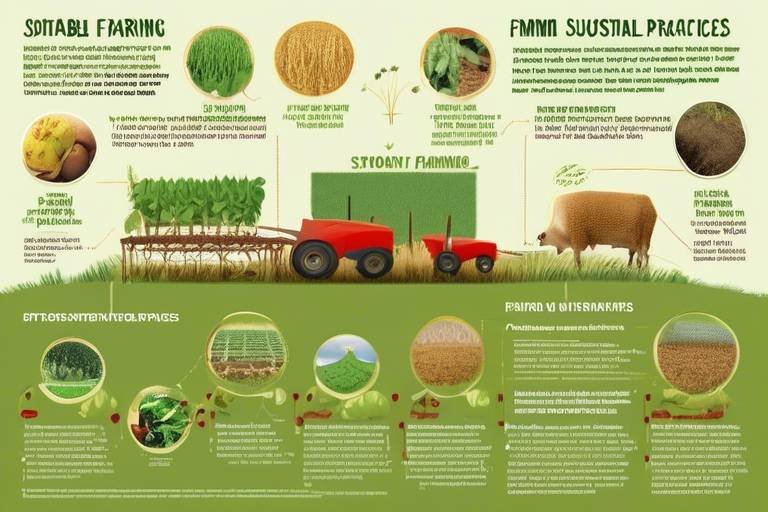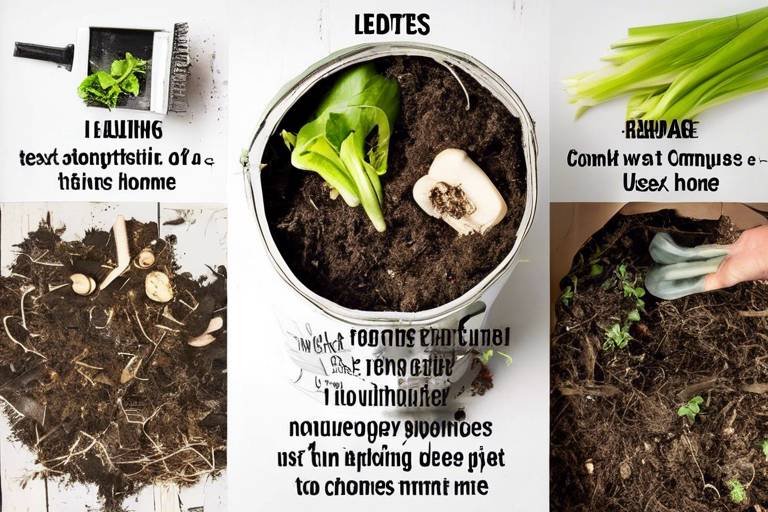What is a Green Diet and How to Follow It?
The concept of a green diet is gaining traction as more people become aware of the impact their food choices have on both personal health and the environment. Essentially, a green diet emphasizes eating primarily plant-based foods, which not only nourish our bodies but also promote sustainability and eco-friendly practices. Imagine your plate filled with vibrant fruits, crisp vegetables, wholesome grains, and legumes, all working together to create a symphony of flavors and nutrients. This diet is not just about what you eat; it’s a lifestyle choice that echoes a commitment to the planet.
At its core, a green diet revolves around the idea that by choosing foods that are less processed and more aligned with nature, we can enhance our well-being while also reducing our ecological footprint. Think of it as a way to nurture yourself while nurturing the Earth. By focusing on whole, organic, and locally sourced ingredients, you're not only fueling your body with the best nutrients but also supporting local farmers and reducing the carbon emissions associated with transporting food over long distances.
But how do you actually follow a green diet? It might seem daunting at first, especially if you're accustomed to a more traditional way of eating. However, transitioning to a green diet can be both simple and rewarding. Start by incorporating more fruits and vegetables into your meals. Aim for a colorful variety, as different colors often signify different nutrients. For example, leafy greens like spinach and kale are packed with vitamins, while orange and yellow vegetables like carrots and bell peppers provide essential antioxidants.
Another important aspect of a green diet is being mindful of food waste. Did you know that nearly one-third of all food produced globally is wasted? By planning your meals and using leftovers creatively, you can significantly reduce your waste and make the most of what you buy. Consider keeping a list of meals you can make from leftover ingredients, turning potential waste into delicious new dishes.
Additionally, it's important to stay hydrated. Water is essential, and opting for filtered water or herbal teas can be a great way to keep your body hydrated without the added sugars and chemicals found in many beverages. Remember, hydration is a key component of any healthy diet!
In summary, a green diet is not just a trend; it's a lifestyle choice that can lead to improved health and a healthier planet. By focusing on whole, plant-based foods and reducing waste, you can make a significant impact on both your well-being and the environment. So why not take the plunge and start your journey towards a greener plate today?
- What foods are included in a green diet? A green diet primarily includes fruits, vegetables, whole grains, nuts, seeds, and legumes.
- Can I still eat meat on a green diet? While a green diet emphasizes plant-based foods, some people choose to include small amounts of sustainably sourced meat or fish.
- How can I ensure I’m getting enough protein? Plant-based proteins can be found in legumes, nuts, seeds, and whole grains, so incorporating a variety of these foods will help meet your protein needs.
- Is it expensive to follow a green diet? While some organic foods can be pricey, buying seasonal and local produce can help reduce costs significantly.

Understanding the Green Diet
The concept of a green diet revolves around embracing a lifestyle that prioritizes plant-based foods, sustainability, and eco-friendly practices. This dietary approach is not just a trend; it's a commitment to making choices that benefit both our health and the environment. Imagine treating your body like a garden, where every meal is a seed sown for a healthier future. By focusing on foods that are rich in nutrients and low in environmental impact, we can cultivate a vibrant life while nurturing the planet.
At its core, the green diet encourages individuals to consume more fruits, vegetables, whole grains, legumes, nuts, and seeds. These foods are not only packed with essential vitamins and minerals but are also typically lower in calories and higher in fiber, making them a fantastic choice for those looking to improve their overall health. Furthermore, a green diet emphasizes the importance of sourcing food sustainably. This means choosing organic, local, and seasonal produce whenever possible, which helps to reduce the carbon footprint associated with food transportation and supports local economies.
Adopting a green diet also involves being mindful of food waste. In a world where millions suffer from hunger, wasting food is not just irresponsible; it's a moral dilemma. By planning meals effectively and utilizing leftovers creatively, we can minimize waste and make the most of every ingredient. Picture this: instead of tossing out wilted greens, you could blend them into a smoothie or toss them into a stir-fry. Every little effort counts, and it all contributes to a more sustainable lifestyle.
Moreover, the green diet is more than just about what we eat; it's about how we eat. This includes practices such as
- Reducing meat consumption
- Opting for plant-based alternatives
- Choosing foods with minimal packaging
- Supporting ethical farming practices
In summary, understanding the green diet is about recognizing the interconnectedness of our food choices, our health, and the environment. By shifting our focus toward more sustainable eating habits, we can create a ripple effect that leads to positive changes not just for ourselves, but for future generations. So, are you ready to dig into the benefits of a green diet and see how it can transform your life and the world around you?

Benefits of a Green Diet
Adopting a green diet is like giving your body and the planet a refreshing makeover. Imagine the vibrant colors of fresh vegetables and fruits, the rich flavors of whole grains, and the satisfaction of knowing you're making a positive impact. The benefits of such a diet are not just skin deep; they extend to your overall health and the environment. Let's dive into the key advantages that come with embracing a green diet.
When you shift towards a plant-based diet, you're not just changing your meals; you're transforming your health. Studies have shown that individuals who follow a green diet often experience significant improvements in their overall well-being. For instance, heart health is greatly enhanced due to the lower levels of saturated fats found in plant foods. Instead of heavy, greasy meals, think of filling your plate with colorful salads, hearty legumes, and wholesome grains. These foods are packed with essential nutrients that support your heart and keep your arteries clear.
One of the most appealing aspects of a green diet is its potential for weight management. Plant-based foods are typically lower in calories yet higher in nutrients. This means you can eat larger portions without the guilt of consuming too many calories. Imagine savoring a bowl of quinoa mixed with roasted veggies and a splash of olive oil—delicious and satisfying! This not only helps in maintaining a healthy weight but also keeps you feeling full longer, reducing the urge to snack on unhealthy options.
Research has consistently shown that a green diet can play a crucial role in preventing chronic diseases such as diabetes, hypertension, and even certain types of cancer. The secret lies in the abundance of antioxidants, vitamins, and minerals found in plant foods. These nutrients work together to strengthen your immune system and reduce inflammation in the body. Think of it as giving your body a shield against diseases! For example, a diet rich in leafy greens, berries, and nuts can significantly lower your risk of developing type 2 diabetes. It's like having your own personal health guard, keeping you safe from potential threats.
Now, let's talk about the planet. Choosing a green diet is one of the most effective ways to reduce your carbon footprint. By consuming more plant-based foods, you contribute to a significant decrease in greenhouse gas emissions. It’s like planting seeds of change for the Earth! According to studies, the livestock industry is responsible for a large percentage of global emissions, while plant-based diets require fewer resources like water and land. By opting for fruits, vegetables, and grains, you're not just nourishing your body; you're also nurturing the environment.
In fact, the environmental benefits can be summarized in a simple table:
| Aspect | Impact of a Green Diet |
|---|---|
| Greenhouse Gas Emissions | Significantly lower compared to meat-based diets |
| Water Usage | Reduced consumption of water resources |
| Biodiversity | Encourages conservation and restoration of ecosystems |
By choosing a green diet, you’re not just making a personal health choice; you’re participating in a larger movement towards sustainability and environmental stewardship. It’s a win-win situation for both you and the planet!
- What foods are included in a green diet? A green diet primarily focuses on fruits, vegetables, whole grains, legumes, nuts, and seeds while minimizing animal products.
- Can I still eat meat on a green diet? While a green diet emphasizes plant-based foods, some people choose to include small amounts of meat or dairy occasionally.
- How can I transition to a green diet? Start by incorporating more plant-based meals into your week, experimenting with new recipes, and gradually reducing your intake of animal products.

Health Benefits
Adopting a green diet can be a game-changer for your health, offering a treasure trove of benefits that can transform your well-being. Imagine feeling more energized, vibrant, and alive—all from the simple act of choosing more plant-based foods. When you embrace a green diet, you're not just making a choice for your plate; you're also making a choice for your overall health. This dietary shift is rich in fruits, vegetables, whole grains, and legumes, which are packed with essential nutrients, vitamins, and minerals that your body craves.
One of the most significant health benefits of a green diet is its potential to improve heart health. Studies have shown that individuals who consume a diet high in plant-based foods tend to have lower cholesterol levels and reduced blood pressure. This means you're not just adding years to your life; you're adding life to your years! By incorporating foods like leafy greens, berries, and nuts into your meals, you can support your heart and reduce the risk of cardiovascular diseases.
But that's not all! A green diet can also play a pivotal role in weight management. Plant-based foods are generally lower in calories and high in fiber, which means they keep you feeling full longer without the extra calories. Think of it this way: when you fill your plate with colorful vegetables and hearty grains, you're not just nourishing your body; you're creating a beautiful, satisfying meal that helps you maintain a healthy weight. In fact, research suggests that people who follow a plant-based diet often find it easier to shed those stubborn pounds compared to those who consume a meat-heavy diet.
Moreover, the benefits of a green diet extend to chronic disease prevention. Research has consistently shown that a plant-based diet can lower the risk of developing chronic diseases such as type 2 diabetes and hypertension. The secret lies in the antioxidants and phytochemicals found in fruits and vegetables, which help combat inflammation and oxidative stress in the body. By choosing a green diet, you're not just eating for today; you're investing in a healthier future.
To illustrate these points further, let's take a look at a table that summarizes some of the key health benefits associated with a green diet:
| Health Benefit | Description |
|---|---|
| Improved Heart Health | Lower cholesterol levels and blood pressure through the consumption of plant-based foods. |
| Weight Management | Lower calorie intake and higher fiber content help in maintaining a healthy weight. |
| Chronic Disease Prevention | Reduced risk of diseases like diabetes and hypertension due to anti-inflammatory properties of plant foods. |
In conclusion, a green diet is not just a trend; it’s a lifestyle choice that can lead to remarkable health improvements. By focusing on whole, plant-based foods, you’re not only nourishing your body but also paving the way for a healthier future. So, why not take the plunge? Your body will thank you!
- What is a green diet? A green diet emphasizes plant-based foods and eco-friendly practices to promote health and sustainability.
- Can I lose weight on a green diet? Yes! A green diet can help with weight management due to its lower calorie and higher fiber content.
- Will I get enough protein on a green diet? Absolutely! There are plenty of plant-based protein sources, such as legumes, nuts, and whole grains.

Weight Management
When it comes to , adopting a green diet can be a game-changer. Imagine filling your plate with vibrant, colorful fruits and vegetables instead of bland, calorie-dense foods. Not only do plant-based foods tend to be lower in calories, but they’re also packed with essential nutrients that keep your body functioning at its best. Think of it as trading in a heavy, clunky vehicle for a sleek, fuel-efficient one—both get you where you need to go, but one does it with much less effort and impact on the environment.
One of the reasons a green diet is effective for weight management is the high fiber content found in most plant-based foods. Fiber is like the unsung hero of weight loss; it keeps you feeling full longer, which means you’re less likely to reach for those unhealthy snacks. Foods such as beans, lentils, whole grains, fruits, and vegetables are all excellent sources of fiber. This not only helps control hunger but also supports healthy digestion and can prevent overeating.
Additionally, many plant-based foods are naturally low in fat. For example, consider the difference between a hefty cheeseburger and a hearty quinoa salad loaded with fresh veggies. The salad not only has fewer calories but also provides a wealth of vitamins and minerals your body craves. It's like choosing a refreshing swim over a heavy workout; both are beneficial, but one is more enjoyable and sustainable in the long run.
To further illustrate the impact of a green diet on weight management, let’s look at a comparison of common foods:
| Food Item | Calories (per serving) | Fiber (grams) | Fat (grams) |
|---|---|---|---|
| Cheeseburger | 300 | 2 | 18 |
| Quinoa Salad | 180 | 5 | 3 |
| French Fries | 365 | 3 | 17 |
| Vegetable Stir-Fry | 200 | 4 | 5 |
As you can see from the table, the quinoa salad and vegetable stir-fry not only have fewer calories but also provide more fiber, which is critical for feeling satisfied and maintaining energy levels throughout the day. This is crucial for anyone looking to manage their weight effectively.
Moreover, a green diet encourages mindful eating practices. When you focus on whole, unprocessed foods, you naturally become more aware of what you’re consuming. This mindfulness can lead to healthier choices and portion control, which are essential components of any weight management strategy. So, next time you’re at the grocery store or preparing a meal, ask yourself: “Is this food nourishing my body?” If the answer is yes, you’re on the right track!
In conclusion, embracing a green diet can significantly aid in weight management through its focus on nutrient-dense, low-calorie foods, high fiber content, and promotion of mindful eating. It’s not just about shedding pounds; it’s about fostering a healthier relationship with food and your body. So, why not give it a try? Your body—and the planet—will thank you!
- What are the best foods for weight management on a green diet? Foods like leafy greens, whole grains, legumes, and fruits are excellent choices.
- Can I still eat meat on a green diet? While a green diet emphasizes plant-based foods, you can include small amounts of lean meats or fish if you choose.
- How quickly can I expect to see results? Weight management varies for everyone, but many people notice changes within a few weeks of adopting a green diet.

Chronic Disease Prevention
When we think about our health, it's easy to focus on the immediate benefits of our dietary choices, such as energy levels and weight management. However, the long-term impact of what we eat is equally important, especially when it comes to preventing chronic diseases. A green diet, rich in plant-based foods, has been shown to play a remarkable role in reducing the risk of various chronic diseases, including diabetes, heart disease, and hypertension. But how does this happen?
First off, let's talk about the power of nutrient density. Plant-based foods are packed with vitamins, minerals, antioxidants, and fiber, all of which are crucial for maintaining good health. For instance, fruits and vegetables are not just low in calories; they are also high in essential nutrients that help the body combat inflammation—a key factor in many chronic diseases. When you fill your plate with colorful veggies and fruits, you're essentially arming your body with a natural defense system.
Moreover, the fiber found in whole grains, legumes, fruits, and vegetables plays a pivotal role in digestive health. It helps regulate blood sugar levels, which is particularly beneficial for preventing type 2 diabetes. A diet high in fiber can also help lower cholesterol levels, reducing the risk of heart disease. Think of fiber as a gentle broom sweeping through your digestive system, keeping things clean and functioning smoothly.
Research has shown that individuals following a green diet experience lower levels of inflammation and improved insulin sensitivity. This means that their bodies are better at managing blood sugar, which is crucial for preventing diabetes. In fact, a study published in the American Journal of Clinical Nutrition found that plant-based diets were associated with a 23% lower risk of developing type 2 diabetes. That's a significant statistic that underscores the importance of what’s on our plates!
Additionally, the consumption of healthy fats, such as those found in avocados, nuts, and olive oil, can further enhance heart health. These fats can help lower bad cholesterol levels while increasing good cholesterol. Imagine your heart as a well-oiled machine; the right fats act like high-quality oil, ensuring everything runs smoothly and efficiently.
To illustrate the impact of a green diet on chronic disease prevention, consider the following table:
| Disease | Benefits of a Green Diet |
|---|---|
| Type 2 Diabetes | Improved insulin sensitivity and blood sugar control |
| Heart Disease | Lower cholesterol levels and reduced blood pressure |
| Hypertension | Increased intake of potassium-rich foods helps regulate blood pressure |
In conclusion, embracing a green diet is not just a fleeting trend; it’s a lifestyle choice that can significantly reduce the risk of chronic diseases. By focusing on whole, plant-based foods, you’re not only nourishing your body but also investing in your long-term health. So, next time you sit down for a meal, remember that every bite is a step towards a healthier future!
- What is a green diet? A green diet emphasizes plant-based foods and sustainable eating practices, focusing on health and environmental benefits.
- Can a green diet help with weight loss? Yes, plant-based foods are typically lower in calories and higher in nutrients, making them effective for weight management.
- How does a green diet affect heart health? A green diet can lower cholesterol levels and blood pressure, reducing the risk of heart disease.
- Is it difficult to transition to a green diet? Not at all! Starting with small changes and gradually incorporating more plant-based meals can make the transition easier.

Environmental Impact
The environmental impact of our dietary choices is profound and far-reaching. Adopting a green diet is not just a personal health decision; it’s a commitment to the planet. When you choose to fill your plate with plant-based foods, you’re actively participating in a movement that aims to reduce the strain on our natural resources and combat climate change. But how exactly does a green diet contribute to a healthier planet? Let’s explore this together.
First and foremost, a green diet significantly lowers greenhouse gas emissions. Animal agriculture is one of the leading contributors to greenhouse gases, accounting for nearly 15% of global emissions. In contrast, plant-based food production typically requires less energy, water, and land. For instance, producing a pound of beef emits about 20 times more greenhouse gases than a pound of lentils. By shifting your focus to plant-based meals, you are making a conscious choice to support a more sustainable food system.
Moreover, a green diet promotes the conservation of natural resources. Water is a precious commodity, and agriculture is a major consumer of freshwater resources. Did you know that it takes approximately 1,800 gallons of water to produce just one pound of beef? In contrast, fruits and vegetables require significantly less water to grow. By reducing meat consumption and embracing a plant-based diet, you are helping to conserve water and ensure that this vital resource is available for future generations.
Additionally, a green diet supports biodiversity. Modern farming practices often rely on monoculture, which can lead to the depletion of soil nutrients and a decline in wildlife habitats. When you choose to eat a variety of fruits, vegetables, legumes, and grains, you are encouraging agricultural diversity and promoting healthier ecosystems. This not only benefits the environment but also enhances the flavors and nutritional value of your meals.
Now, let’s take a look at the comparison of environmental impacts between a typical meat-based diet and a green diet:
| Aspect | Meat-Based Diet | Green Diet |
|---|---|---|
| Greenhouse Gas Emissions (per meal) | High | Low |
| Water Usage (gallons per pound) | 1,800 (beef) | 200 (lentils) |
| Biodiversity | Decreased | Increased |
In conclusion, the environmental impact of adopting a green diet is not just a personal choice but a collective responsibility. By choosing to eat more plants, you are reducing your carbon footprint, conserving water, and protecting biodiversity. It’s a simple yet powerful way to make a difference. So, the next time you sit down for a meal, think about the impact of your food choices on the planet. Every bite counts!
- What is a green diet? A green diet emphasizes plant-based foods, sustainability, and eco-friendly practices aimed at improving health and protecting the environment.
- How does a green diet help the environment? It reduces greenhouse gas emissions, conserves water, and supports biodiversity by promoting diverse agricultural practices.
- Can a green diet be affordable? Yes, focusing on seasonal and local produce can make a green diet budget-friendly while also supporting local farmers.
- What are some easy ways to start a green diet? Begin by incorporating more fruits, vegetables, and whole grains into your meals, and gradually reduce meat consumption.

How to Start a Green Diet
Transitioning to a green diet might seem daunting at first, but it can be a fun and fulfilling journey! Imagine swapping out your usual meals for vibrant, plant-based dishes that not only tantalize your taste buds but also nourish your body and the planet. The key to starting this diet lies in understanding that it’s not about strict rules but rather about making conscious choices that lead to a healthier lifestyle. So, how do you begin?
First and foremost, meal planning is crucial. Take some time each week to plan your meals. This doesn’t mean you have to stick to a rigid schedule, but having a rough idea of what you want to eat can help you make better choices. Think about including a variety of fruits, vegetables, whole grains, nuts, and seeds in your meals. A colorful plate is not just visually appealing; it also ensures you’re getting a range of nutrients. For instance, you might plan a week where:
| Day | Breakfast | Lunch | Dinner |
|---|---|---|---|
| Monday | Green smoothie with spinach and banana | Quinoa salad with chickpeas and veggies | Stir-fried tofu with broccoli and brown rice |
| Tuesday | Oatmeal topped with berries and nuts | Vegetable wrap with hummus | Lentil soup with whole grain bread |
| Wednesday | Chia pudding with almond milk | Mixed green salad with avocado | Stuffed bell peppers with quinoa |
This simple meal plan showcases how easy it can be to incorporate plant-based foods into your diet. Remember, it’s all about balance and variety! Don’t hesitate to experiment with different recipes and ingredients. You might discover new favorites that you never thought you’d enjoy.
Next up is shopping smart. Knowing where to shop and what to buy can make a significant difference in your green diet journey. Opt for organic, seasonal, and local produce whenever possible. Not only does this support local farmers, but it also reduces your carbon footprint since the food doesn’t have to travel far. When you’re in the grocery store, look for items that are minimally packaged. You can even bring your own reusable bags and containers to cut down on waste.
Additionally, consider joining a local community-supported agriculture (CSA) program. This is a fantastic way to get fresh, seasonal produce delivered to your doorstep while supporting local agriculture. Plus, it adds an element of surprise to your meals as you might receive vegetables you’ve never cooked with before!
Lastly, don’t forget to stay hydrated. Water plays a vital role in any diet, and it’s especially important when you’re eating more fiber-rich foods. Aim for at least eight glasses of water a day, and feel free to infuse it with fruits or herbs for added flavor. You might be surprised at how refreshing a cucumber-mint water can be!
- Can I still eat meat on a green diet? Yes! A green diet emphasizes plant-based foods, but you can still enjoy meat in moderation. The focus is on increasing your intake of fruits and vegetables.
- How do I ensure I get enough protein? Plant-based sources of protein include beans, lentils, tofu, quinoa, and nuts. Incorporating these into your meals can help you meet your protein needs.
- What if I don’t like vegetables? There are countless ways to prepare vegetables that can make them more appealing. Try roasting, grilling, or blending them into smoothies. You might find you like them more than you thought!

Meal Planning
Meal planning is a game changer when it comes to adopting a green diet. Imagine walking into your kitchen with a clear plan, knowing exactly what to cook for the week, and avoiding the dreaded "what's for dinner?" dilemma. Not only does meal planning save you time, but it also helps you make healthier choices by reducing the temptation to grab fast food or processed snacks. So, how do you get started on this delicious journey?
First off, it's essential to set aside some time each week to plan your meals. Grab a notebook or use an app—whatever works best for you. Begin by checking what you already have in your pantry and fridge. This way, you can incorporate those ingredients into your meal plans, minimizing waste. It's like a treasure hunt in your own kitchen!
Next, think about the core principles of your green diet. Focus on incorporating a variety of plant-based foods—fruits, vegetables, whole grains, legumes, nuts, and seeds. A colorful plate is not just visually appealing; it also ensures you're getting a range of nutrients. Aim to include a different color on your plate each day; it's like eating a rainbow!
When planning your meals, consider the following tips:
- Batch Cooking: Prepare large portions of meals that can be stored for later. Dishes like soups, stews, and casseroles are perfect for this. You can easily freeze leftovers for a quick meal later in the week.
- Theme Nights: Make meal planning fun by having theme nights, such as "Meatless Mondays" or "Taco Tuesdays." This adds excitement to your week and keeps you motivated.
- Seasonal Produce: Always try to incorporate seasonal fruits and vegetables into your meal plans. Not only are they fresher and tastier, but they also have a lower environmental impact due to reduced transportation needs.
Once you've got your meals planned, create a shopping list based on your menu. This will help you stay focused while shopping and prevent impulse buys. When you're at the store, opt for organic and local produce whenever possible. This not only supports local farmers but also reduces your carbon footprint.
Finally, don't forget to keep your meals interesting! Experiment with different recipes and cooking techniques. Try new grains like quinoa or farro, and explore various cooking methods like steaming, roasting, or grilling. The more you play with your food, the more you'll discover what you love, making it easier to stick to your green diet.
In summary, meal planning is not just about food; it's about creating a lifestyle that prioritizes health and sustainability. With a little effort and creativity, you can transform your dining experience while making a positive impact on the planet.

Shopping Tips
When embarking on your journey toward a green diet, one of the most impactful steps you can take is to rethink your shopping habits. It's not just about what you eat; it's also about where and how you source your food. Imagine walking through a vibrant farmers' market, surrounded by fresh, colorful produce, and knowing that your choices are not only nourishing your body but also supporting local farmers and the environment. So, how can you make your shopping trips more aligned with a green diet? Let's dive into some practical tips!
First and foremost, prioritize organic produce. Organic farming practices are designed to be more sustainable and environmentally friendly, avoiding synthetic pesticides and fertilizers that can harm both your health and the ecosystem. While organic options might be slightly more expensive, consider it an investment in your health and the planet's future. Look for labels that indicate organic certification, which ensures that your food is grown without harmful chemicals.
Next, try to shop for seasonal and local produce. Not only does this support local economies, but it also reduces the carbon footprint associated with transporting food long distances. Seasonal fruits and vegetables are typically fresher and more flavorful, making your meals not just healthier but also tastier. For instance, in the summer, you might find an abundance of tomatoes, cucumbers, and zucchini, while fall brings in hearty squash and apples. By planning your meals around what's in season, you can enjoy a diverse and vibrant diet throughout the year.
Another great tip is to consider joining a community-supported agriculture (CSA) program. This is a fantastic way to receive fresh, local produce directly from farmers. By subscribing to a CSA, you get a weekly box of seasonal fruits and vegetables, which can inspire you to try new recipes and ingredients. Plus, it fosters a deeper connection between you and the food you consume, as you learn about the farming practices and the people behind your meals.
When at the grocery store, be mindful of packaging. Opt for products that use minimal or recyclable packaging. This small change can lead to a significant reduction in waste. For example, choose loose fruits and vegetables instead of pre-packaged ones, and bring your own reusable bags to carry your groceries home. Not only does this help reduce single-use plastics, but it also sets a positive example for others in your community.
Lastly, don't forget to check the labels on processed foods. Many items may seem healthy at first glance, but they can contain hidden sugars, preservatives, and unhealthy fats. Look for products with short ingredient lists and recognizable items. If you're unsure, a good rule of thumb is to stick to foods that your great-grandmother would recognize as food. This approach not only simplifies your shopping experience but also encourages healthier eating habits.
In summary, transforming your shopping habits is a crucial step towards embracing a green diet. By focusing on organic, seasonal, and local produce, participating in community-supported agriculture, being mindful of packaging, and scrutinizing labels, you can make informed choices that benefit both your health and the environment. Happy shopping!
- What is a green diet? A green diet emphasizes plant-based foods, sustainability, and eco-friendly practices to improve health and reduce environmental impact.
- How can I start a green diet? Begin by incorporating more plant-based meals into your diet, shopping for organic and local produce, and practicing mindful eating.
- Are there any health benefits to a green diet? Yes, a green diet can lead to improved heart health, weight management, and a lower risk of chronic diseases.
- What should I look for when shopping for a green diet? Focus on organic, seasonal, and local produce while minimizing packaged foods and reading labels carefully.
Frequently Asked Questions
- What is a green diet?
A green diet focuses on consuming primarily plant-based foods while promoting sustainability and eco-friendly practices. It encourages eating fresh fruits, vegetables, whole grains, nuts, and seeds, reducing reliance on animal products.
- What are the health benefits of a green diet?
Adopting a green diet can lead to numerous health improvements, including better heart health, weight management, and a reduced risk of chronic diseases such as diabetes and hypertension. The nutrient-dense nature of plant-based foods contributes to overall well-being.
- How does a green diet impact the environment?
A green diet significantly reduces your carbon footprint by lowering greenhouse gas emissions associated with animal agriculture. By choosing plant-based foods, you contribute to resource conservation and biodiversity enhancement, making a positive impact on the planet.
- Can I still enjoy my favorite foods on a green diet?
Absolutely! A green diet doesn’t mean you have to give up your favorite meals. You can find plant-based alternatives or modify recipes to include more vegetables and grains, allowing you to enjoy delicious and satisfying meals while being eco-conscious.
- How can I start transitioning to a green diet?
Starting a green diet can be easy! Begin by incorporating more plant-based meals into your week. Meal planning is essential; try to prepare balanced dishes that include a variety of colorful vegetables, whole grains, and legumes.
- What shopping tips can help me maintain a green diet?
When shopping, look for organic, seasonal, and local produce to enhance your green diet. Farmers' markets are a great place to find fresh, sustainable options. Additionally, reading labels can help you avoid processed foods that may not align with your dietary goals.
- Is a green diet suitable for everyone?
While a green diet is beneficial for many, individual dietary needs may vary. It's important to consider personal health conditions and preferences. Consulting with a healthcare professional or a nutritionist can help tailor a green diet that works for you.



















